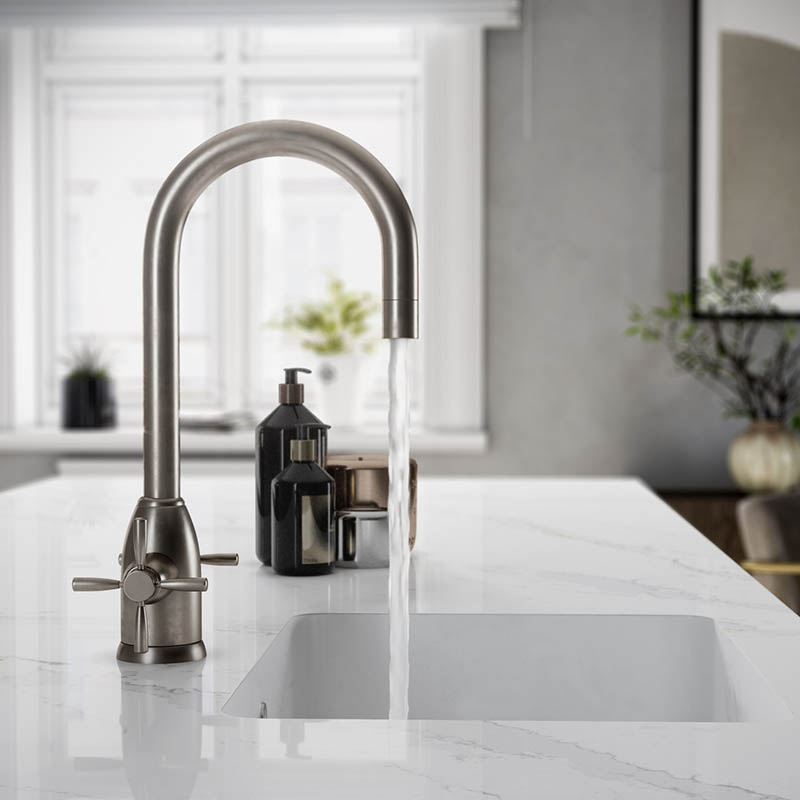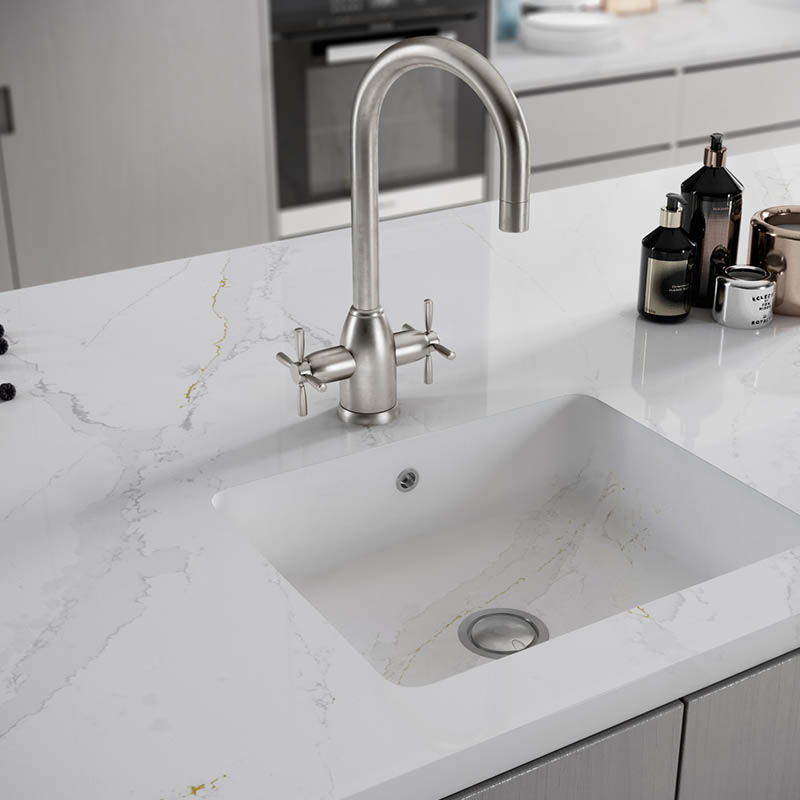Calacatta marble countertops have gained immense popularity in recent years due to their stunning beauty and luxurious appeal. This natural stone, characterized by its distinctive veining and bright white background, adds a touch of elegance and sophistication to any kitchen or bathroom. However, like any material, Calacatta marble has its own set of pros and cons that homeowners should consider before making a decision. In this article, we will explore the various aspects of Calacatta marble countertops, discussing their advantages, disadvantages, and everything in between.

This article interest may you. Which kitchen countertop to choose?
Pros of Calacatta Marble Countertops
Calacatta marble offers numerous benefits that make it a desirable choice for homeowners who seek to elevate the aesthetics of their spaces. Let’s delve into some of the pros of Calacatta marble countertops:
1. Exquisite Beauty
Calacatta marble is renowned for its exquisite beauty and timeless elegance. With its striking veining patterns, ranging from delicate and fine to bold and dramatic, this marble variety creates a visually stunning focal point in any room. Its bright white background, often accented with gold or gray veins, adds a touch of luxury and sophistication, making it a highly sought-after material for countertops.
2. Unique Veining Patterns
One of the distinguishing features of Calacatta marble is its unique veining patterns. Each slab of Calacatta marble is distinct, ensuring that your countertop will be one-of-a-kind. The veining can vary from slab to slab, presenting homeowners with the opportunity to select the specific pattern that resonates with their personal style and preferences.
3. High Durability
Marble, including Calacatta, is a durable material that can withstand the test of time. When properly sealed and maintained, Calacatta marble countertops can last for decades, making them a long-term investment for your home. The density and hardness of Calacatta marble contribute to its durability, ensuring that it can handle the rigors of daily kitchen or bathroom use.
4. Heat Resistance
Another advantage of Calacatta marble countertops is their excellent heat resistance. This makes them an ideal choice for kitchens, where hot pots, pans, and other cooking utensils are frequently placed on the countertop. Calacatta marble can withstand high temperatures without suffering damage, providing peace of mind and convenience during culinary endeavors.
5. Enhances Property Value
Investing in Calacatta marble countertops can significantly enhance the value of your property. Due to its association with luxury and elegance, Calacatta marble is often viewed as a high-end material, appealing to potential buyers and increasing the overall desirability of your home. This makes it a wise choice for homeowners who are looking to add value to their property while enjoying its beauty and functionality.
6. Natural and Eco-Friendly
Calacatta marble is a natural stone, quarried from the earth’s crust, making it an eco-friendly choice for environmentally conscious individuals. By opting for Calacatta marble countertops, you can reduce your carbon footprint and contribute to sustainable practices in the construction and design industry.
Cons of Calacatta Marble Countertops
While Calacatta marble offers a myriad of advantages, it’s important to consider the potential drawbacks associated with this material. Let’s explore some of the cons of Calacatta marble countertops:
1. High Maintenance
Calacatta marble requires regular maintenance to keep its pristine appearance intact. Being a porous material, it is susceptible to staining and etching from acidic substances, such as citrus juices and certain cleaning agents. To mitigate these risks, it’s crucial to seal the marble regularly and promptly clean up spills to prevent permanent damage.
2. Vulnerable to Scratches
Like other types of marble, Calacatta is prone to scratching. While it is a durable material, it is softer than granite and quartz, making it more susceptible to surface scratches. Using cutting boards, trivets, and other protective measures can help minimize the risk of scratches on your Calacatta marble countertops.
3. Limited Color Options
Calacatta marble is predominantly characterized by its white background with bold veining. While this is a sought-after aesthetic for many homeowners, it may not appeal to those seeking a wider range of color options. If you’re looking for countertops in different colors or patterns, you may need to consider alternative materials.
4. Cost Considerations
Calacatta marble is considered a luxury material, and its price reflects this status. It tends to be more expensive than other countertop options, such as granite or quartz. If you have budget constraints, Calacatta marble may not be the most cost-effective choice for your project. However, its durability and timeless appeal can offset the initial investment over time.
5. Susceptibility to Etching
As mentioned earlier, Calacatta marble is vulnerable to etching. Etching refers to the dull spots or marks that occur when acidic substances come into contact with the marble surface. While sealing the marble can provide some protection, it’s essential to exercise caution and avoid using harsh or acidic cleaning agents to prevent etching.
6. Weight Considerations
Calacatta marble is a heavy material, which can pose challenges during installation. The weight of the slabs may require additional structural support, and it’s crucial to ensure that your cabinets and countertops can withstand the load. Consulting with professionals experienced in marble installation is advisable to ensure a successful and secure installation process.
FAQs about Calacatta Marble Countertops
- Q: Are Calacatta marble countertops prone to staining?
- A: Calacatta marble is a porous material, making it susceptible to staining. Proper sealing and regular maintenance can help protect against stains.
- Q: Can I place hot pans directly on Calacatta marble countertops?
- A: Calacatta marble has excellent heat resistance, allowing you to place hot pans directly on the surface without causing damage.
- Q: How often should Calacatta marble countertops be sealed?
- A: It is recommended to seal Calacatta marble countertops every 6 to 12 months, depending on usage and the specific sealant used.
- Q: Can scratches be repaired on Calacatta marble countertops?
- A: Minor scratches on Calacatta marble can often be repaired with polishing techniques. However, deep scratches may require professional assistance.
- Q: Can I use abrasive cleaners on Calacatta marble countertops?
- A: No, abrasive cleaners should be avoided as they can cause etching and damage the surface of Calacatta marble. Use mild, non-abrasive cleaners instead.
- Q: Can I install Calacatta marble countertops myself?
- A: Due to the weight and complexity of the installation process, it is recommended to hire professionals experienced in working with Calacatta marble to ensure proper installation.
Conclusion
Calacatta marble countertops offer a stunning combination of beauty, durability, and luxury. From its exquisite veining patterns to its high heat resistance, Calacatta marble has much to offer homeowners looking to elevate their spaces. However, it’s important to consider the maintenance requirements, susceptibility to scratches and etching, as well as the cost associated with this material. By carefully weighing the pros and cons, you can make an informed decision and create a timeless and visually captivating space with Calacatta marble countertops.

